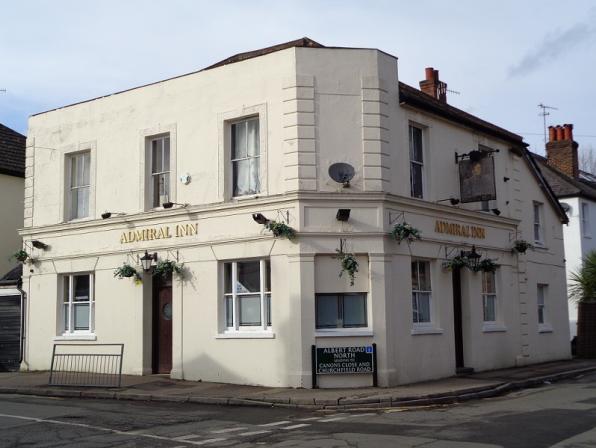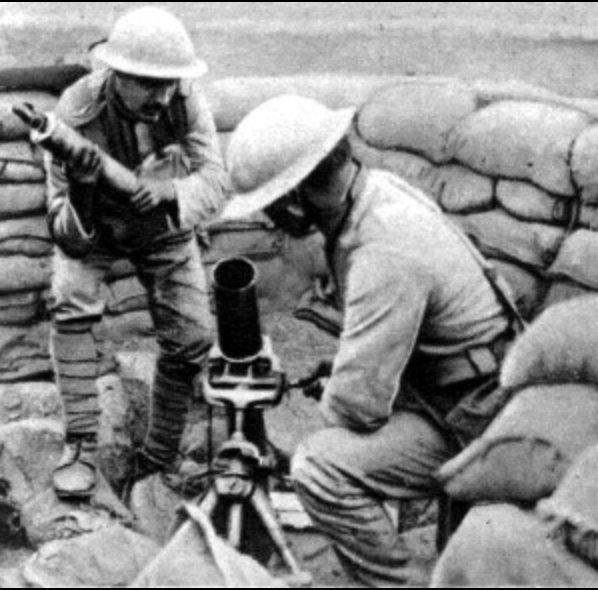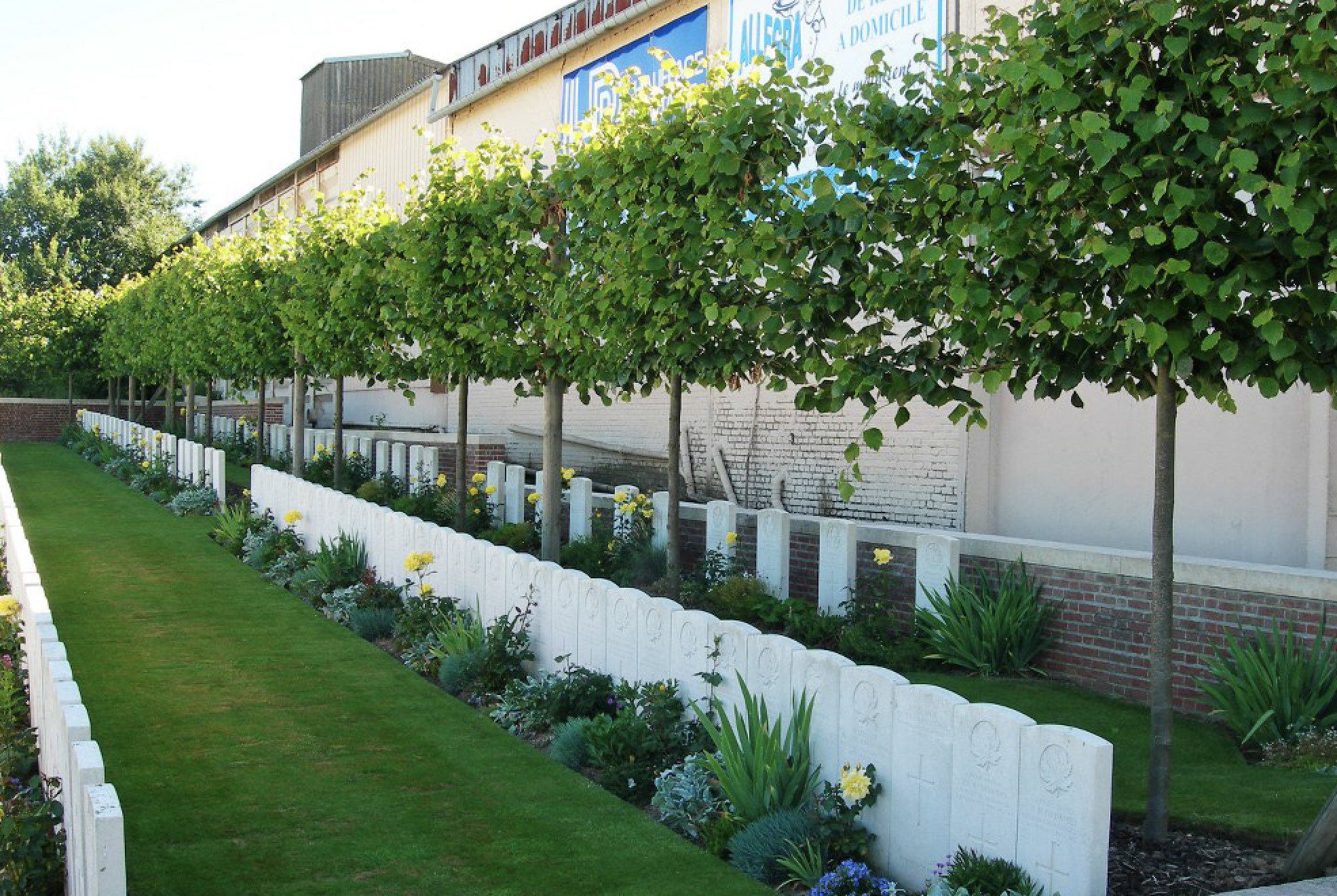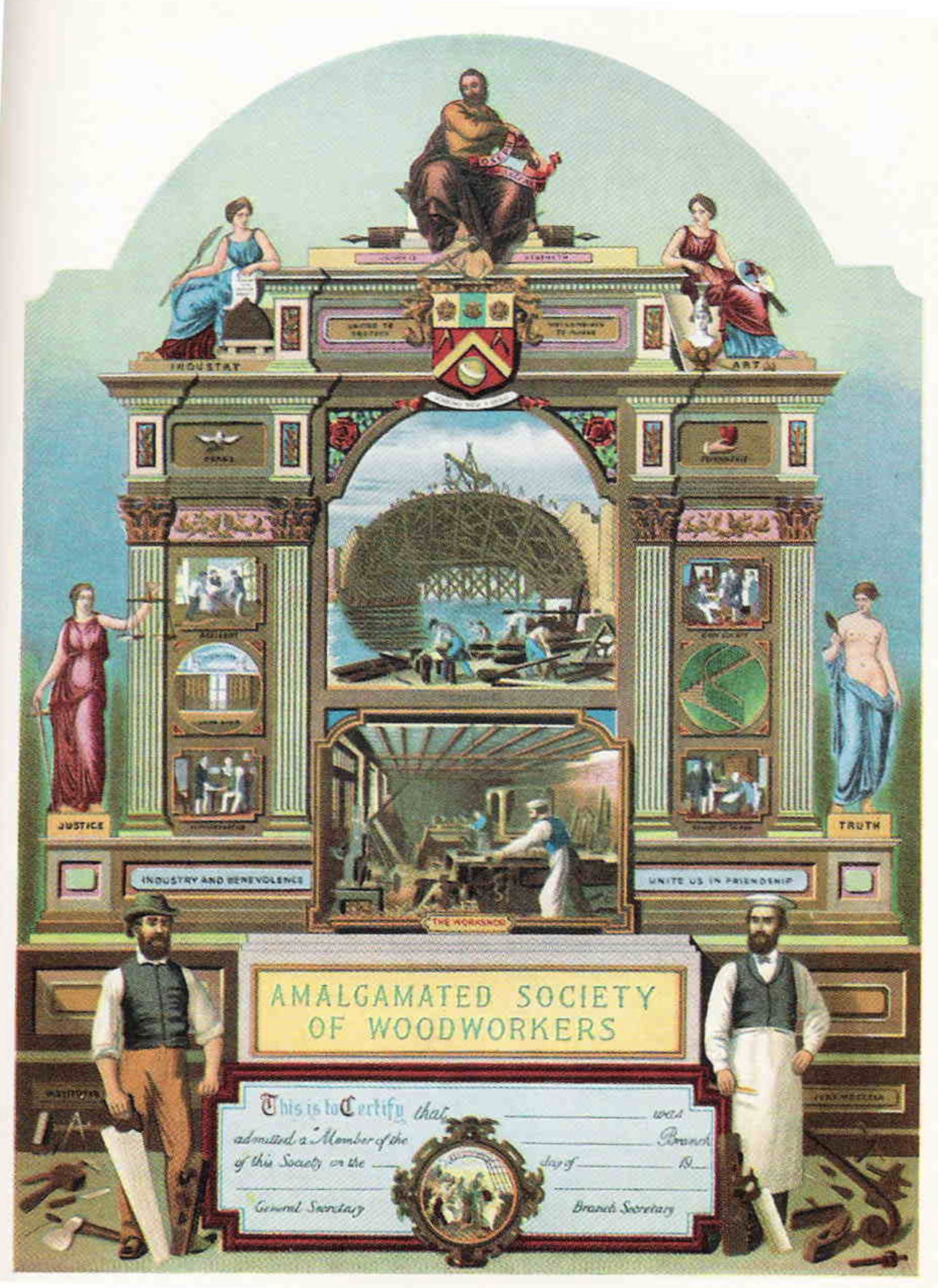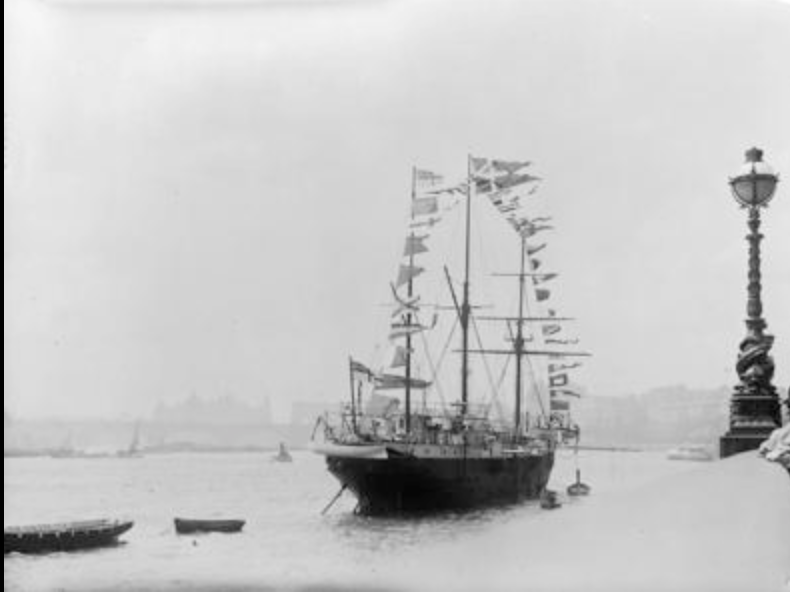Fallen in December 1917:
George Albert Baker
William George Fensom
GEORGE ALBERT EDWARD BAKER
130686 Serjeant
No.1 Special Coy., Royal Engineers
Died of Wounds Saturday, 1st December 1917
Remembered with Honour, Windmill British Cemetery, Monchy-Le-Preux, Pas-de-Calais, France Grave I. G. 21.
George Albert Edward Baker was born in Reigate, Surrey on Saturday, 27th November 1880 and was baptised two months later on Sunday 30th January 1881. He was born to George and Mary Jane Baker. George’s father, George Snr., was a ‘Publican’ and ran the Admiral Pub, where George was born, on Nutley Lane, in Reigate. The pub still stands today.
It is not known how George came to Hemel Hempstead, but he was living and working in the area when he met Florence Alice Birchmore, a local girl from Boxmoor and they soon became sweethearts. George married Florence at St John the Evangelist Church in Boxmoor on Monday, 16th April 1900. Florence had been baptised in the same church, as an adult, only three years previously along with her baby brother Sidney.
The young couple set up home at 14 Albert Street, in nearby Watford, where George worked as a ‘House Painter’ and ‘Gas Fitter’. In January 1901, Florence gave birth to their first child, a boy they named George Sidney Arnold. Two years later in 1903, he was followed by his little sister Florence Violet Priscilla. By the time of the next census in 1911, the family had moved a short distance to 17 Merton Road, Watford and George worked for Rickmansworth Urban District Council as a ‘Gas Fitter’.
Sometime after 1911 George came back to Hemel Hempstead with his family when he started work in Home Park Mills for John Dickinson & Co. Limited. He moved to 63 Horsecroft Road in Boxmoor with his wife and children and it was from there that he went to war. Florence did not remarry after George was killed and she continued to live in the same house at 63 Horsecroft Road until her death in 1961, when she was eighty-eight years old.
John Dickinson was the largest employer in the area and on the outbreak of war many eligible employees immediately sought to enlist. The diary of Home Park Mills where George worked, recorded the following: “Our men went so willingly that it was rather a question of restraining indispensable men from volunteering rather than urging any of our men to go. The retreat from Mons [23rd August to 5th September 1914] had its effect on our men as on the whole of our countrymen and the reverses only increased the number of those who felt it their duty to enlist”
The whole of John Dickinsons, including Home Park Mills, became dedicated to the war effort and the employees who remained were engaged in the production of trench mortars. These jobs were ‘starred’ or reserved, and in 1916, following the passing of the Military Service Act, Dickinsons fought hard in the local ‘Tribunals’ to ensure it retained skilled men to continue this important work. Over 1600 men did leave the company to volunteer and thirteen former employees from Home Park Mills lost their lives in the Great War.
George sought permission to enlist from his employer and attested at Hemel Hempstead in October 1914, enlisting with the Hertfordshire Regiment. He was posted to the 2nd Battalion at Hertford to begin his basic training. By early November 1914 the 2nd Herts already had its full complement of men and recruiting ceased.
George’s trade as a ‘Gas Fitter’ meant that he was soon singled out and transferred to train with one of the new ‘Special Companies’ of the Royal Engineers. The Great War was the first in which chemical weapons were deployed. There was great moral shock and outrage at the first use of Chlorine, released by the Germans against defenceless French troops in the Ypres Salient. The Special Companies of the Royal Engineers were formed to develop the British response. By 1918, gas was used both offensively and defensively, delivered by a range of sophisticated techniques. George’s experience as a Gas Fitter suited him to the task and he joined other technically skilled men to begin his training. All the men of the Special Companies were given the rank ‘Chemist Corporal’
He had completed his training by early 1916 and he was sent overseas, posted to 5th (Mortar) Battalion No.1 Special Company Royal Engineers, which was allocated to the Third Army. This was a section specialised in handling and firing gas shells from 4-inch Stokes mortars. Each Company was made up of four sections each armed with twelve weapons.
Much of George’s time in France was spent laying down gas shell bombardment at the start of attacks, so he saw action throughout 1916 and 1917. By November, now promoted Serjeant, he was in the vicinity of Cambrai in France and took part in the Operations there, starting on the 20th November.
Cambrai was the first mass attack by British Tanks supporting the assaulting troops and despite initial success, particularly the capture of Bourlon Wood, the actions soon turned to tragedy. The Germans launched a massive counter-attack and over three days bombarded the allied soldiers in the captured wood with over 16,000 shells. This all but wiped out some battalions and inflicted a huge number of casualties.
In late November and early December the German retaliation continued to good effect until the Battle concluded on the 7th December. The official figures state that around 44,000 allied troops and 179 tanks were lost, whilst the Germans incurred 45,000 casualties.
George was one on this huge number of men to fall and was wounded as some point in the early action. He was taken out of the line and evacuated to No.10 Field Ambulance but he did not recover from his injuries.
He died of his wounds on Saturday, 1st December 1917.
He is commemorated on the John Dickinson & Co. Limited War Memorial in Apsley and on the War Memorial Plaque in St. John the Evangelist Church, Boxmoor where he and Florence had married.
George is Remembered with Honour in the Windmill British Cemetery, Monchy-Le-Preux, Pas-de-Calais, France where he is interred in Grave I. G. 21. The inscription on his headstone, requested by his wife Florence, reads: “GONE BUT NOT FORGOTTEN”.
He was 37 years old when he died.
George was eligible for the British War Medal and the Allied Victory Medal.
The Admiral Inn, Reigate today, where George was born (Photo: WhatPub)
John Dickinson, Home Park Mills, Kings Langley (Photo: Apsley Paper Trail)
One of the Special Companies, Royal Engineers with Gas Mortars (Photo: Dan Morton)
Loading Gas Mortars (Photo: Public Domain)
John Dickinson & Co. Limited War Memorial, Apsley (Photo:Traquair Photography)
War Memorial Plaque, St. John the Evangelist Church, Boxmoor (Photo: Traquair Photography)
Windmill British Cemetery, Monchy-Le-Preux, Pas-de-Calais, France, (Photo: CWGC)
WILLIAM GEORGE FENSOM
F/2606 Petty Officer
R.N. Air Station (Dunkerque), Royal Naval Air Service
Died of Wounds Wednesday, 12th December 1917
Remembered with Honour, Ipswich Old Cemetery, Suffolk, England, Grave BA. IA. 19.
William George Fensom was born in Hemel Hempstead, Hertfordshire on Thursday, 10th May 1877 and baptised a year later on Friday, 21st June 1878 at St Mary’s Church, along with his younger brother Charles. He was born to William Fensom and Eliza Ann Dyer who had eleven children together, four of whom died young. The surviving children were: William George, Charles Harry, Randall, Margaret Winifred, Muriel Doris, Eveline Alice and Reginald.
The Fensom family lived on Queen Street in Hemel Hempstead, in a house known as “The Shanty”, when William was born and his father William Snr., worked as a ‘Turner’ or ‘Joiner’. By the 1901 census, William Snr. was running a ‘Carpentry and Building’ business from his home at 25 Queen Street and his wife Eliza Ann, ran a ‘Music Warehouse’ from the same address. William Snr. died in 1924 and had an estate worth the substantial sum of £2204, approximately £94,000 today, which he bequeathed to his son Charles.
William was a ‘carpenter’ and moved to London to work. In 1901 he was a boarder at the home of Robert Carey, another carpenter, who may have been his employer. The Carey home was at 27 Moreton Place in Pimlico, London and of the residents present on the day of the census, four were recorded as ‘carpenters’. In 1906 he was admitted to the Chelsea branch of the Amalgamated Union of Carpenters and Joiners.
Whilst living in London he met Annie May Abbass Soffe and they became sweethearts and married in early 1903 in Chelsea. By the time of the next census in 1911, William and Annie had produced a family of seven children, one of whom died at birth. The children were: Mary May, Richard Harold, Phyllis, Frank William, Joan and the youngest Norah. The family lived at 30 Beaconsfield Road, Pimlico just a short walk from Seven Sisters underground station and William was a ‘carpenter’ with a building firm.
Following William’s death, Annie did not remarry and spent the remainder of her life in Chiswick, where she had been born. She died in June 1953 at the age of seventy-four.
Shortly after the outbreak of war, William volunteered and enlisted with the Royal Naval Air Service as an ‘Air Mechanic’ on the 8th December 1914. The Royal Naval Air Service (RNAS) was the air arm of the Royal Navy, under the direction of the Admiralty's Air Department. It existed formally from the 1st July 1914 to the 1st April 1918, when it was merged with the British Army's Royal Flying Corps to form the Royal Air Force, the world's first independent air force. The main "naval" roles of the RNAS were fleet reconnaissance, patrolling coasts for enemy ships and submarines, and attacking enemy coastal territory.
William was posted to a shore training establishment, Pembroke III, where he stayed until the end of March 1915, when he was posted to President II. This was another shore establishment and William remained at this base for the next two years, until it transferred to Dunkirk in March 1917 and he went overseas.
During his training and active service he had quickly risen through the ranks and by the time he went to France, he had been promoted Petty Officer Mechanic. He spent eight months in France at the Dunkirk Air Base with No.10 Naval Squadron, with the exception of a brief nine day period of leave on the 1st November.
William returned to France after his home leave and on the 4th December, he was admitted to 35 General Hospital in Calais for an unrecorded reason, but it was clearly serious enough to result in his transfer back to England.
He sailed back to Dover in Kent on the 12th December and at some point, either during the crossing or shortly after his arrival, William took his own life. William’s death certificate records that his suicide was due to “temporary insanity brought on by active service”, and undobtedly the reason for his hospitalisation in Calais.
During World War 1, it is estimated that 80,000 British soldiers suffered from what was generally referred to as ‘Shell Shock’ In reality this was a general term which covered all manner of stress and trauma related conditions experienced by soldiers from all sides.
Nevertheless, William had been a willing volunteer and during his service he was noted to be of; “Very Good” character and “Satisfactory” ability, aspects reflected in his rapid promotion to Petty Officer. He was the last soldier from Hemel Hempstead, commemorated on the War Memorial at Boxmoor, to die during 1917.
He was commemorated on the War Memorial Plaque in St. Mary's Church, High Street, Hemel Hempstead where he had been baptised.
William is Remembered with Honour in the Ipswich Old Cemetery, Suffolk, England, where he is interred in Grave BA. IA. 19. The inscription on his headstone, requested by his wife Florence, reads: “GONE BUT NOT FORGOTTEN”.
Ipswich Old Cemetery, Suffolk, England (Photo: CWGC)
He was 40 years old when he died.
William was eligible for the British War Medal and the Allied Victory Medal.
Queen Street, Hemel Hempstead where William grew up (Photo: Dacorum Heritage Trust)
Membership certificate of the Amalgamated Union of Carpenters and Joiners (Image:http://www.unionancestors.co.uk)
"President II" (HMS Buzzard) on the Thames 1907. William's posting before being sent to France (Photo: Public Domain)
War Memorial Plaque, St. Mary's Church, High Street, Hemel Hempstead (Photo: Traquair Photography)
P.O. William Fensom - headstone in Ipswich Old Cemetery (Photo: BillionGraves)
